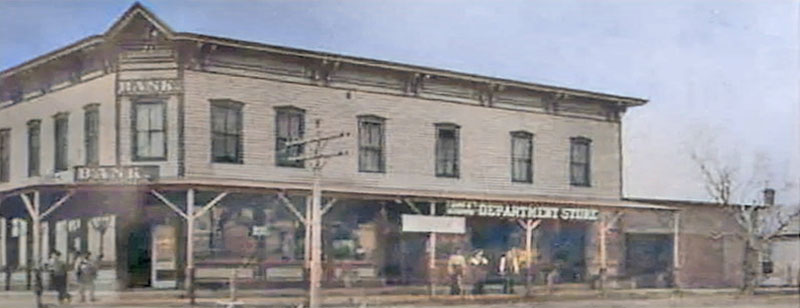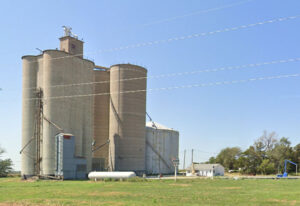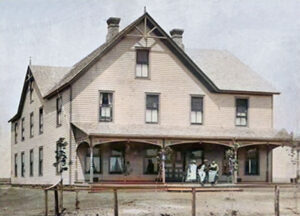| Town | Post Office Dates | Additional Information |
| Albion-Gourock | 1878-1902 | Gourcok was established in 1878 on the Chikaskia River in the western-central part of the county. A post office was established on July 30, 1878. In 1880, it had a district school, tri-weekly mail delivery, and stagecoaches running through Wellington and Harper. The town was laid out on March 4, 1881, on land formerly owned by J. W. Shields but purchased by a town company of which T. Shields was the president. The first building was put up by F.E. Beach, the second by Elder Bros., and the third by Portman & Maddy. The name changed from Gourcok to Albion in January 1883. By that time, it had no churches but had four stores, a lumber yard, a hotel, two liveries, a meat market, two blacksmith shops, and a population of about 100. A flouring mill was built previously built here but was never put in operation. In 1885, Albion had a good district school and shipped grain and livestock. A stagecoach ran tri-weekly to Roy, Rex, and Midlothian; mail was delivered daily. At that time, the town boasted the Albion City Mills, the Wolf River Lumber Company, Elder Bros & Hutchinson General Store, J.V. Portman’s Grocery Store, a livery, a druggist, two shoemakers, three carpenters, a blacksmith, an insurance agent, a sheep breeder and several men who raised livestock. The population was 60. It was 17 miles south of Elk Falls, the nearest shipping point, and one mile west of Argonia. The post office closed on December 15, 1902. |
| Bluff Creek | 1878-1887 | Bluff Creek was a small town on a creek of the same name. Little is known about Bluff Creek’s formation. The first postmaster was G.S. Reid. In 1885, it had a Methodist Church, a district school and shipped livestock from Caldwell, which was also its nearest banking point. It was on the daily mail stage route from Anthony to Caldwell, from which mail was delivered to S.G. Bird, the postmaster. It was located in southeast Harper County, 16 miles southeast of Anthony, the county seat, and 15 west of Caldwell. The post office moved to Bluff (City) in February 1887. |
| Camchester-Cameron | 1893-1903 | This town was first called Cameron when a post office was established on June 2, 1893. The name changed to Camchester on February 2, 1900, and the post office closed on March 31, 1903. |
| Corwin | 1883-1957 |
A village of Blaine Township, Cowwin was a station on the Missouri Pacific Railroad. In 1910, it had a money order post office, telegraph and express offices, telephone connections, a hotel, good local trade, and a population of 125. It was the principal shipping point for the southwestern part of the county. Its post office closed on June 28, 1957. It is 17 miles southwest of Anthony, the county seat. |
| Crisfield | 1885-1951 | A village of Greene Township, in 1910, it was a station on the Atchison, Topeka & Santa Fe Railroad, with a money order post office, telegraph and express offices, telephone connections, some general stores, a population of 50, and a shipping and supply point for that section of the county. |
| Crystal Springs | 1885-1976 | A village of Lake Township, the post office was established on January 16, 1885. It soon had a depot, stockyards, and two grain elevators. Amish Mennonites settled it in the early 1900s and the Crystal Springs Mennonite Church was moved here from McPherson County. |
| Curran | 1892-1903 | The Curran post office was located on land owned by J.C. Curran. During the years the post office was open, it was the only post office in Garden Township. |
| Duquoin | 1883-1975 |
Duquoin is an extinct town in Grant Township in the northern part of the county, Walter E. Fitch was the first postmaster. In 1885, mail was delivered twice a week by stage from Harper, which was its nearest railroad and banking point. It shipped grain and produce and had a blacksmith, a carpenter, a grocer, and a population of 100. In 1910, it was a station on the Atchison, Topeka & and Santa Fe Railroad. At that time, it had telegraph and express offices, a money order post office with one rural route, general stores, two grain elevators, a flour mill, and a population of 75. In 1868, there was a two-teacher school with 20 students located three miles south of Duquoin, and it had a grain elevator with 200,000-bushel capacity, a grocery store, the Church of Christ with 35 members, and a population of 13. It was 18 miles northwest of Anthony, the county seat. |
| Embry | 1885-1889 | Embry was laid out in 16 blocks, four blocks long and four blocks wide. Main Street extended north and south, dividing the town equally. The town was located on the St. Louis, Fort Scott & Wichita Railroad. The first postmaster was William F. Stocker. It was located five miles east and one mile north of Anthony. |
| Ferguson | 1904-1918 | Ferguson was a Kansas City, Mexico & Orient Railroad station in Eagle Township. It was two miles southwest of Anthony, the county seat. It was a market for livestock and grain.. The population in 1910 was 40. In the next years, the railroad tracks were removed and the church was disbanded. |
| Freeport | 1885-2016 | Freeport, Kansas, is an unincorporated community and ghost town in Harper County. It is also officially an extinct town, as its post office is closed. As of the 2010 census, the community’s population was five. |
| Goss | 1892-1896 | After Giles M. Goss arrived in Harper County, helped establish the town of Harper, and acquired 1,400 acres. The little village of Goss came into being on his property. |
| Inyo | 1879-1893 | In 1885, this small town was on the daily mail stage route from Harper to Medicine Lodge, its nearest banking point. J.B. Doolittle ran a general store. It was 25 miles northwest of Anthony and 20 west of Harper, the nearest shipping point. |
| Joppa | 1879-1884 | Located in Bluff Creek Valley, the first postmaster was John A. Squires. Shortly after the town was platted, it soon had several stores, a blacksmith, and a stage stand. |
| Midlothian | 1879-1885 | The post office moved to Freeport. |
| Otego | 1882-1885 | Located three miles north and three-fourths east of Crisfield, the first postmaster was George W. Clark. At one time, Mr. Rankin operated a store there. When the post office closed, it was moved to Crisfield. |
| Ruby | 1902-1904 | Located on the Rock Island Railroad, Leonard K. Belding operated a store and was the first postmaster. |
| Ruella | 1884-1899 | Located on the Missouri Pacific Railroad, the first postmaster was Branson Jackson. At one time, it had a large depot that served four passenger trains per day, a store, a blacksmith shop, and several homes. |
| Runnymede | 1879-1944 |
Runnymede, Kansas, was an unincorporated community in the northeastern part of Harper County, not far from the Kingman County line. It is an extinct town today, as its post office closed decades ago. |
| Shook | 1901-1925 | This hamlet was located in Eagle Township. In 1910, it was onthe Missouri Pacific Railroad and had a money order post office, a general store, and a population of 20. It was eight miles southwest of Anthony, the county seat. |
| Sonora | 1880-1888 | Located on land owned by Azariah Culbertson, he became the first postmaster. |
| Sullivan | 1885-1886 | |
| Swan | 1879-1880 | |
| Waldron | 1902-2003 | Waldron was a station on the Chicago, Rock Island & Pacific, and the Kansas City, Mexico & Orient Railroads in 1810. At that time, it had several retail stores, a bank, a weekly newspaper called the Argus, telegraph and express offices, a money order post office, and a population of 262. It is located 14 miles southwest of Anthony. Today, it is a ghost town, and as of the 2020 census, its population was nine. |
| Yankton | 1883-1884 | The first postmaster was Stephen C. Oliver, located in Ruella Township. The town boasted the Yankton Gleaner, an eight-page, eight-column newspaper, an attorney, a dentist, a livery, a shoemaker, and the Yankton Hotel. |
©Kathy Alexander/Legends of Kansas, November 2024.
Also See:
Sources:
1884-1885 Gazetteer and Business Directory, R.L. Polk & Company, Detroit, MI.
Blackmar, Frank W.; Kansas: A Cyclopedia of State History, Vol I; Standard Publishing Company, Chicago, IL 1912.
Cutler, William G; History of Kansas; A. T. Andreas, Chicago, IL, 1883.
Fort Hays State University
Kansas Post Office History




